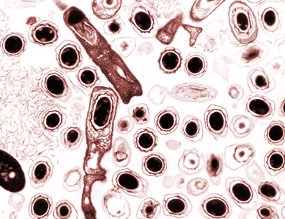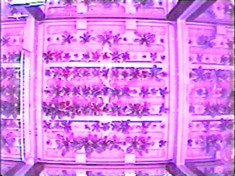|
Industry-sponsored and NASA research aimed
at growing plants in space has led to a device that attacks and
destroys airborne pathogens - like Anthrax.
By Dr Tony Phillips
Unseen and odourless, a cloud of Anthrax
spores wafts through an office. People inside are talking, laughing
... breathing. They have no idea something is in the air. One yawn,
one gasp, one happy guffaw could be deadly.
That's how bioterrorism works.
But this office has a defence: Bolted
to the ceiling is a curious flat box. It's made of metal, about
the size of a table-top, and it's humming softly - the sound of
fans drawing airborne spores toward it and away from the people.
The breeze is gentle but insistent. Eight cubic feet of air per
minute flow into the box.
What lies inside is bad news for Anthrax.
Swirling air forces spores through a bewildering maze of thin tubes
bristling with hydroxyl (OH-) ions that attack and destroy
pathogens. Some spores are buffeted against the OH-lined
walls of the labyrinth. Others are caught in windy eddies where they
linger, exposed to high-energy (254 nm) ultraviolet photons. Every
second, one hundred billion such photons bathe the chamber - and just
one is enough to destroy a spore.
"Spores that pass through the box aren't
filtered, they're fried," says John Hayman, whose company, KES Science
& Technology, Inc., builds and sells the device called AiroCide
TiO2. "That's appealing," he notes, "for people who
don't want to change an Anthrax-laden air filter." Tests show that
as many as 93% of Anthrax spores that enter AiroCide TiO2
are destroyed. Survivors circulate out of the chamber where
they are likely to be sucked back in again for another pass.
This extraordinary Anthrax killer is a
result of NASA and industry-sponsored research aimed at building better
greenhouses in space. "Greenhouses may seem to have little to do with
the war against terror," says Mark Nall, the director of NASA's Space
Product Development (SPD) program. "But this shows how space research,
along with its direct benefits, also helps people on Earth in indirect
and unexpected ways."

Anthrax
spores, pictured here in a
thin section micrograph, are inactive forms of the bacterium
Bacillus anthracis. Such bacteria can survive for decades
inside a spore's tough protective coating; they become active
when inhaled by humans.
|
Hayman explains: "[Space faring] astronauts
will eventually need to grow some of their own food in greenhouses.
But there's a problem: the leaves of growing plants release ethylene
(C2H4) - a gas that causes fruits and vegetables to mature." In
the close quarters of a spacecraft (or inside an enclosed plant
growth chamber), ethylene would build up and ripen greenhouse plants
prematurely.
Space greenhouses needed a new technology
to remove that ethylene.
In the 1990's, University of Wisconsin
professor Marc Anderson and colleagues from the Wisconsin Centre
for Space Automation and Robotics (WCSAR) made a crucial discovery:
They found that ultra-thin layers of titanium dioxide (TiO2)
exposed to ultraviolet light would efficiently convert ethylene
into carbon dioxide (CO2) and water (H2O)
- substances that are good for plants. Titanium dioxide itself is
a harmless, non-toxic colouring agent used in
many consumer products. It is a catalyst for the ethylene-destroying
reaction; no TiO2 is consumed.
TiO2-based ethylene removers
have since flown to space inside a pair of plant growth chambers:
ASTROCULTURE™ on board NASA's space shuttle and ADVANCED ASTROCULTURE™
on the International Space Station (ISS). The devices were built
by WCSAR - a NASA Commercial Space Centre at the University of Wisconsin.
WCSAR is one of 17 such centres around the country sponsored by
NASA's Space Product Development program to encourage the commercialisation
of space by industry.

A top-down view of the ADVANCED
ASTROCULTURE™ plant growth chamber on the ISS, where
reddish light illuminates the leafy heads of Arabidopsis
plants.
|
The technology worked so well that the
University of Wisconsin collaborators joined forces with KES Science
and Technology, Inc., to develop an ethylene scrubber for Earth. The
device, called Bio-KES, works wonders in supermarkets where
ethylene in the air of produce aisles reduces the shelf life of vegetables.
Bio-KES was nominated as Discover Magazine's Product of the
Year in 1998, and it's since been shipped across the globe for use
by grocers and florists.
Moreover, Bio-KES is the parent
of AiroCide TiO2.
"It was a serendipitous discovery,"
recalls Hayman. Tests showed that Bio-KES not only removed
ethylene, but also killed airborne dust mites. Marc Anderson quickly
realised why: When ultraviolet (UV) photons strike something coated
by TiO2 - like the tubes inside Bio-KES - positive
and negative charges appear on its surface. Those charges tear apart
nearby water molecules. The OH- ion, a by-product of
the reaction, disrupts organic molecules. It's deadly to dust mites,
Anthrax and many other pathogens.
Technicians modified Bio-KES
- adding higher-power UV lamps, for example, to give it "an extra
kick," says Hayman - and AiroCide TiO2 was born.

In a laboratory
at the University of Wisconsin, a plexiglass chamber (left)
containing airborne spores covers the entrance to an AiroCide
TiO2 unit. Few microbes survive a journey through
the machine. The exit port (right) reveals glowing UVC lamps
inside.
|
Dean Tompkins, a colleague of Anderson's
at the University of Wisconsin, is in charge of testing AiroCide
TiO2. "We don't use real Anthrax," he notes. "That
would be too dangerous. Instead, we experiment with one of its non-virulent
cousins: Bacillus thurengiensis." During a typical experiment,
Tompkins propels a cloud of approximately 1000 spores through the
AiroCide chamber. Only 100 or so emerge intact.
Spores that enter AiroCide TiO2
spend at least 5 to 10 seconds in transit through the device. "That's
important," adds Hayman, "because pathogens that remain inside longer
are more likely to die." To slow the spores, TiO2-coated
tubes within the unit are randomly arranged - there's no direct
path through the machine. When air moves across the jumbled tubes,
the flow becomes turbulent - forcing spores to linger where they
can be attacked by OH- and illuminated by germ-killing
ultraviolet light
Such powerful tools against bio-terror
indeed seem a far cry from star-trekking greenhouses, but that's
how many discoveries are made: You never know what new invention
might emerge - like AiroCide TiO2 - or what
might be annihilated in the process - like Anthrax!
|
